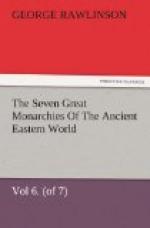The history of Volagases II. ends with this transaction. No events are assignable to the last ten years of his reign, which was probably a season of profound repose, in the East as it was in the West—a period having (as our greatest historian observes of it) “the rare advantage of furnishing very few materials for history,” which is, indeed (as he says), “little more than the register of the crimes, follies, and misfortunes of mankind.” The influence of Rome extended beyond his borders. As in modern times it has become a proverb that when a particular European nation is satisfied the peace of the world is assured, so in the days whereof we are treating it would seem that Rome had only to desire repose, for the surrounding nations to find themselves tranquil. The inference appears to be that not only were the wars which occurred between Rome and her neighbors for the most part stirred up by herself, but that even the civil commotions which disturbed States upon her borders had very generally their origin in Roman intrigues, which, skilfully concealed from view, nevertheless directed the course of affairs in surrounding States, and roused in them, when Rome thought her interests required it, civil differences, disorders, and contentions.
The successor of Volagasos II. was Volagases III., who was most probably his son, although of this there is no direct evidence. The Parthian coins show that Volagases III. ascended the throne in A.D. 148 or 149, and reigned till A.D. 190 or 191—a space of forty-two years. We may assume that he was a tolerably young man at his accession, though the effigy upon his earliest coins is well bearded, and that he was somewhat tired of the long inactivity which had characterized the period of his father’s rule. He seems very early to have meditated a war with Rome, and to have taken certain steps which betrayed his intentions; but, upon their coming to the knowledge of Antoninus, and that prince writing to him on the subject, Volagases altered his plans, and resolved to wait, at any rate, until a change of Emperor at Rome should give him a chance of taking the enemy at a disadvantage. Thus it was not till A.D. 161—twelve years after his accession—that his original design was carried out, and the flames of war were once more lighted in the East to the ruin and desolation of the fairest portion of Western Asia.
The good Antoninus was succeeded in the spring of A.D. 161 by his adopted son, Marcus Aurelius, who at once associated with him in the government the other adopted son of Antoninus, Lucius Verus. Upon this, thinking that the opportunity for which he had been so long waiting had at last arrived, Volagases marched his troops suddenly into Armenia, expelled Sosemus, the king protected by the Romans, and established in his place a certain Tigranes, a scion of the old royal stock, whom the Armenians regarded as their rightful monarch. News of this bold stroke soon reached the governors of the adjacent Roman provinces,




